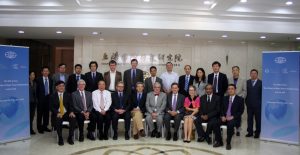Memo #259
By Yves Tiberghien – yves.tiberghien [at] ubc.ca
In the wake of major leadership change around East Asia, what will be the major trends in the Asia/Pacific region in 2014? Did the battle over the Chinese Air Defense Identification Zone (ADIZ) and the provocative visit to Yasukuni Temple by Prime Minister Abe on December 26 represent only transitory events, or do they mark a new lasting trajectory? What matters most is whether leaders manage to correct the tit-for-tat cycle of misperceptions and symbolic moves, so as to focus on shared institutional steps. The year 2014 is a fork in the road.
On the one hand, the wheels of integration continue to grind forward. The region will host both the APEC summit (Beijing) and the G20 summit (Brisbane) in November. While the two great regional mega-FTAs (Trans-Pacific Partnership, or TPP, and Regional Comprehensive Economic Partnership, or RCEP) seemed to collide in early 2013, a rapprochement between the US and China and the completion of the small Bali WTO agreement in December have allowed more bridge-building. The early harvest fruits from both Abenomics in Japan and structural reforms initiated at the Third Plenum of the CCP in China could stabilize internal political cycles and enable leaders to seek possible mutual gains.
On the other hand, there continues to be a fundamental gap between global economic forces and the instrumentalization of national symbols by entrepreneurial leaders on the domestic scene. Crucial elections in India in May will test whether the country doubles down on economic reforms and integration or faces internal paralysis. The same can be said for Indonesian elections in July 2013, while Thailand’s future is hanging on the edge of the fragmentation precipice. China is engaging into a delicate rebalancing of its economic structure in the hopes of escaping the middle income trap, all the while reaffirming CCP leadership. And one still awaits pragmatic steps from a more confident Prime Minister Abe to pull his country back from the brink of confrontation with both South Korea and China.
In the coming year, innovative leadership and new efforts at regional institution-building will be direly needed in order to defuse the downward cycle of domestic posturing. In this, the creative mediation of the US, Canada, and Australia will also be key.
About the Author:
Dr. Yves Tiberghien is the Director of the Institute of Asian Research, Executive Director of the China Council, and Associate Professor of Political Science at the University of British Columbia. He is also a Senior Fellow with the Global Summitry Project at the Munk School, University of Toronto.

Participants in the conference “The G20 at Five: ‘New Model of Major Power Relationship’ and the G20,” held in Shanghai in September 2013. Hosted by the Shanghai Institute of International Studies (SIIS) and co-sponsored by SIIS, the Munk School of Global Affairs, and the Stanley Foundation, participants examined the prospects and challenges facing the G20 in the year, and years, ahead.
- Yves Tiberghien, L’Asie et le futur du monde (Presses de Sciences Po), 2012
- Yves Tiberghien, Leadership in Global Institution Building (Minerva’s Rule), 2013
- “Shanghai 2013 Report” (Report from the Shanghai conference, “The G20 at Five”), Global Summitry Project, 2013
- The Global Summitry Project, Munk School of Global Affairs, University of Toronto

Comments are closed, but trackbacks and pingbacks are open.